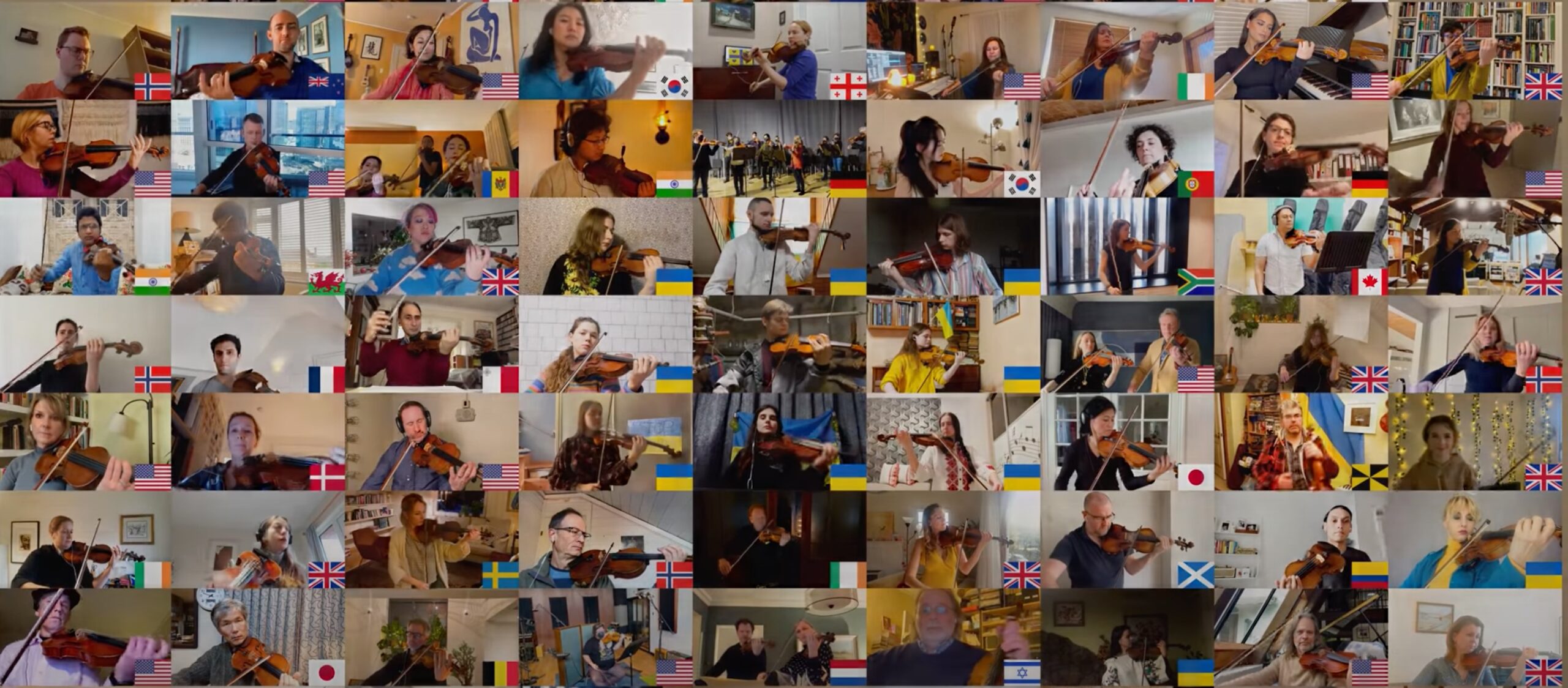Music from Ukraine: A Collaborative Portrait Gallery in March 2022
What of music in the time of war? It is not a new question, but a question whose answers unfold along complex and specific paths.
In the eighteen days since the Russian government’s invasion of Ukraine on February 24, music and musicians have been part of many of this war’s unfolding stories. Here are just a few: War reporters have borne witness to musicians on the front lines. Musical networks, including abroad, have enabled artists to flee, join in military resistance, and otherwise participate in humanitarian aid. Some have compiled albums, the proceeds of which go toward humanitarian relief. Concerts raise funds, too. Historians have spoken out about the libraries and archives—including those with music—at risk.
In Ukraine, music critics issued a call for solidarity from colleagues around the world, providing resources for the performance of art music from Ukraine, especially the national anthem. Outside the territory of war, music scholars have been part of the effort to explain the political, ethnic, and racial tensions at the foundation of this war and which are often negotiated in music from Ukraine.
Earlier stories of music and Ukraine take on new meaning in war; for example, scholarship on musicians from minoritized populations in Ukraine sheds light on the unequal access to asylum for those fleeing the danger of ongoing military aggression. Please be invited to click on these links to learn more about the war and musical work afoot; check out the resource page hosted by the Society for Ethnomusicology and the upcoming Ukrainian Contemporary Music Festival in New York City.
Musicology Now facilitated this collaborative portrait gallery, inviting scholars of Ukrainian music and musicians and scholars from Ukraine to shape brief reflections on a musician or musical ensemble on their minds over the last two weeks. What emerges is a rich quilt of deeply personal writing that is not an encyclopedic introduction to Ukrainian music, but an evocation of Ukraine’s longstanding, dynamic, and multifaceted musical life.
Andrea Bohlman, executive editor at Musicology Now
Sasha Boole
Sasha Boole (a portmanteau of the porn actor Sasha Grey and the mathematician George Boole) is the stage name of Oleksandr Bulich (Bandcamp, Spotify, Facebook). He is a boisterous and self-mythologizing singer-songwriter from Chernivtsi, a city in southwestern Ukraine near the Romanian and Moldovan border. Born in 1989 in Mongolia, where his father was serving in the army, he explains his “American folk music with Ukrainian lyrics” as connecting the storytelling of American folk and blues (he has a tattoo of Hank Williams) with the Ukrainian bardic tradition.
He rejects what he feels are the narrow, backward-looking, and romanticized imagery of “folk” in Ukraine—hopak dancing, baggy sharovary trousers—and the trendiness of Hustul melodies and imagery in mainstream Ukrainian culture (“When you have all the trembity [alpine horns] and tsymbaly [hammered dulcimers] in the soup, in the borshch—it gets to be too much”); in favor of a vision of Americana that is equally romanticized, but has the advantage of being at a physical and psychological distance. Boole has adapted the unionist leftism common to many folk-punk Woody Guthrie fetishists to a radical militancy—he references Upton Sinclair and the American history of progressive organizing in the service of his advocacy for a muscular Ukrainian nationalism. He adopted the hard-touring ethos of peers like British singer-songwriter Frank Turner via routes from Donbass to Germany, Belarus to Moldova; and with a “24 concerts in 24 hours” stunt in Łódź, Poland. He is the author of the novel ПЛЮЩ (Ivy), and composed the soundtrack to the 2016 motorcycle road-trip documentary Dustards.
Franz Nicolay is a musician and the author of the books The Humorless Ladies of Border Control and Someone Should Pay For Your Pain. He teaches music and written arts at Bard College.
Chamber Choir “Chernivtsi”
— Чepнiвцi / Czernowitz / Cernăuți / Czerniowce / טשערנאוויץ —
In September 2017, a marathon concert took place in three buildings of symbolic significance to the western Ukrainian city of Chernivtsi, the Philharmonic Hall, the Eastern Orthodox Paraskewa Church, and the Roman Catholic Parish Church. Taking center stage in the concert was the exquisite Chamber Choir “Chernivtsi,” which performed compositions that set sacred texts in five different languages: Ukrainian, Church Slavonic, Romanian, Greek, and Latin. All settings were by Eusebius Mandyczewski (1857–1929), a local composer who rose to fame as a music scholar in Vienna.
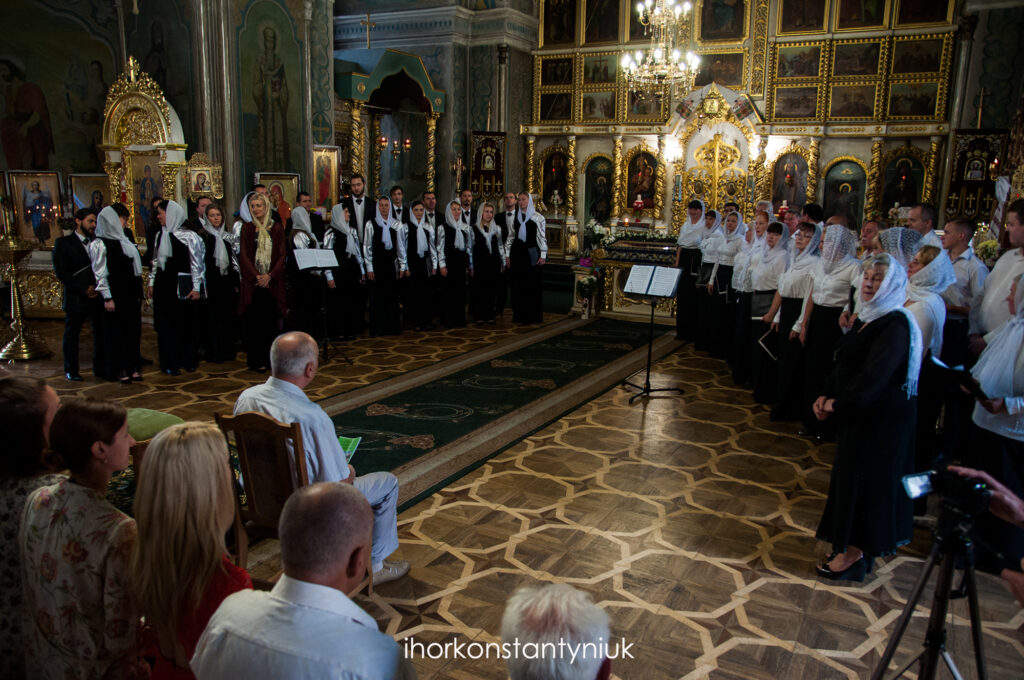
2017 Mandyczewski Festival, performance at the Eastern Orthodox Paraskewa Church. Photo by Ihor Konstantyniuk.
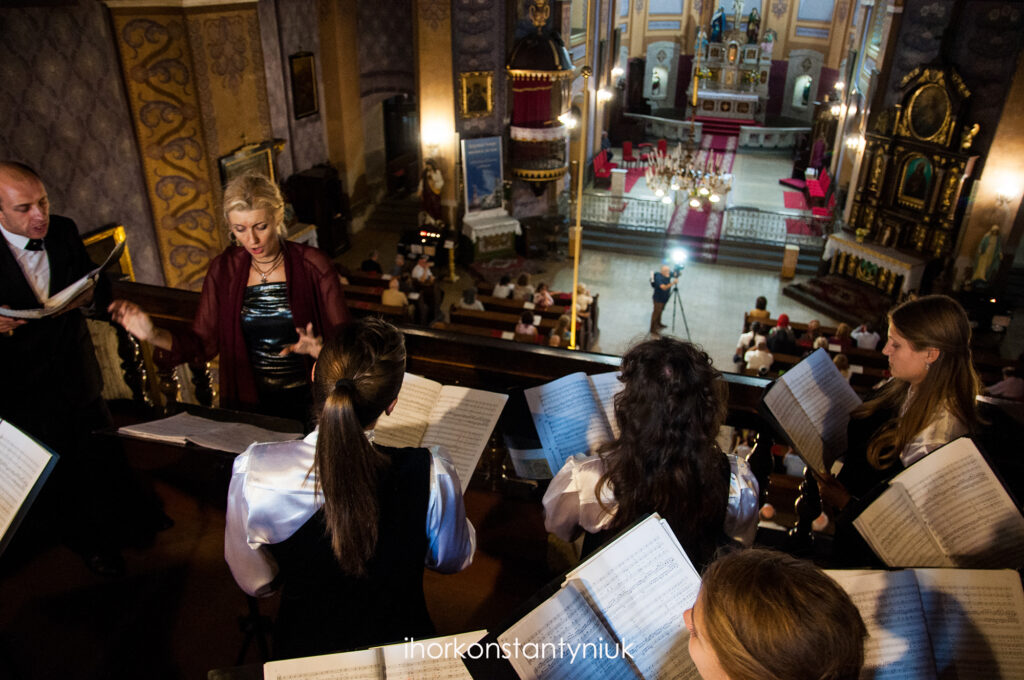
2017 Mandyczewski Festival, performance at the Roman Catholic Church. Photo by Ihor Konstantyniuk.
The award-winning choir, directed by Nadiia Selezniova, is young in two senses: founded in 1993 after Ukraine gained independence, most of its singers are in their twenties or thirties. In 2019 they won first prize at the Hajnówka Festival in Białystok, Poland. They reflect the city’s multicultural fabric, speaking Ukrainian, Russian, and Romanian, and adhering to Eastern Orthodoxy (two singers are priests), Greek Catholicism, or Islam.
The concert was a central component of the Mandyczewski Festival that I initiated after unearthing musical treasures in archives in Chernivtsi, Bucharest (Romania), and Plzeň (Czechia). A joint project with conductors Nadiia Selezniova and Yosyp Sozanskiy and co-organized by Ivanka Andreitsiv, it revived compositions unperformed in a century.
A personal note: after the 2018 festival, we took a train to Kyiv to mount a performance at the National Philharmonic Hall. Before the concert, choir members showed me the stunning Kyiv-Pechersk Lavra, a revered place in Eastern Orthodoxy and symbol for Kyiv’s formidable history. Four years later, the city is under siege, trains groan with refugees, and the plain seen from the monastery is a war zone. In the music that ended our concert, I hear a prayer for a beleaguered home.
Dietmar Friesenegger is a musicologist based at Leipzig University researching Galicia under the auspices of the European Research Council Project, “Opera and Transnationalism in Habsburg Europe.”
The Claquers
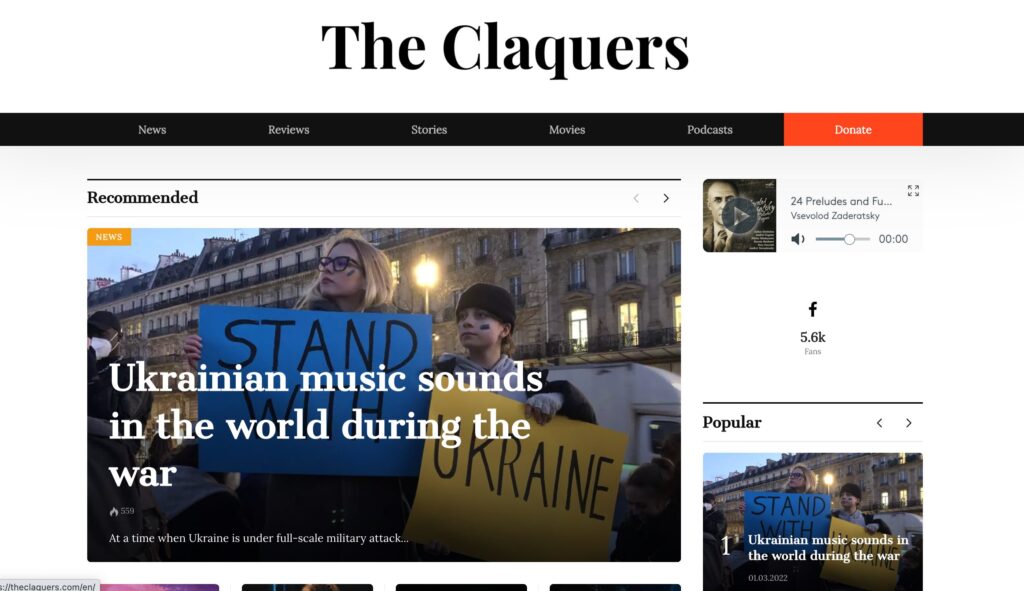
The English-language version of The Claquers’ homepage on March 13, 2022.
The Claquers is a Ukrainian online magazine devoted to classical music that unites a group of music critics with the mission to foster a critical conversation about art music in Ukraine and beyond. The Claquers organization was founded in June 2020 by musicologist Stas Nevmerzhytskyi and three colleagues: musicologist Dzvenyslava Safian, music theorist Liza Sirenko, and cultural critic Oleksandr Ostrovskyi.
The publication’s provocative name suggests the context in which The Claquers was conceived. After two previous generations of proactive critics who had careers in education and cultural promotion, classical music criticism was limited to either positive reviews or no reviews at all. A fresh and uncensored eye on events in classical music life in Ukraine was needed to shake up the musical community and complete the country’s classical music ecosystem.
Unlike in western Europe and North America, art music audiences in Ukraine are much younger. The collective of writers with The Claquers is also young, and has taken on the task of explaining to these new listeners why a long tradition of classical music in Ukraine exists, and how it became a part of today’s cultural life. As a group The Claquers considers its main goals: to educate about contemporary classical Ukrainian music, to build bridges with popular culture by publishing about diverse musical genres and other arts (such as music in literature or in film), to expand the critical tools of music criticism with audio podcasts, and to cultivate audiences abroad via an English version of the website.
The Claquers was made possible by generous funding that enabled its establishment and is sustained by the generosity of donors on Patreon. This singular and engaged Ukrainian online hub devoted to classical music continues to engage people in this music and invite new authors.
Liza Sirenko is a music theorist and music journalist in Ukraine—and a regular contributor to The Claquers.
Ukrainian Chorus DUMKA of New York
DUMKA is a New York-based Ukrainian-American mixed choir that performed “Prayer for Ukraine” (Molytva za Ukrajinu) for a television audience of millions as the opener for Saturday Night Live on February 26, 2022. “Prayer for Ukraine” is a hymn that is often sung in lieu of the Ukrainian national anthem. It was composed in 1885 by Mykola Lysenko (1842-1912) with words by Oleksandr Konysky (1836-1900).
DUMKA shares the name of the Kyiv-based National Academic Choral Capella DUMKA founded in 1919. Political refugees fleeing war-torn Ukrainian lands established the DUMKA choir in New York in 1949. The Ukrainian Chorus DUMKA has preserved and cultivated the rich choral history of Ukraine for more than 70 years.
The choir has performed in prestigious concert halls, including Carnegie Hall, Town Hall, Lincoln Center, as well as Madison Square Garden. In 1988, the choir conducted tours of Europe to commemorate the Thousand Years of Christianity in Ukraine (988-1988), including a performance at Royal Albert Hall in London. In 1990, DUMKA toured Ukraine and performed in Kyiv, Kaniv, Poltava, and Lviv. They have since also performed with the Kyiv-based DUMKA. In 1995 the New York DUMKA earned the prestigious Mykola Lysenko award from the Ministry of Culture and Composers of Ukraine.
Since 1991, the DUMKA choir has been under the direction of Maestro Vasyl Hrechynsky, who earned his degree at the Mykola Lysenko Lviv National Music Academy (also known as the Lviv Conservatory). DUMKA has a musical library of more than 400 works and performs annual concerts of Christmas carols in New York’s St. Patrick’s Cathedral. DUMKA rehearses weekly on the Lower East Side in New York City.
Adriana Helbig teaches ethnomusicology at the University of Pittsburgh and is the author of Hip Hop Ukraine: Music, Race, and African Migration.
Lesia Vasylivna Dychko
Lesia Vasylivna Dychko, renowned particularly for her choral works, is one of the top composers of her generation. She has taught at the Kyiv Conservatory since 1994.
Born in Kyiv in 1939, she graduated from the Kyiv National Musical Academy in composition, studying with Konstantyn Dankevich and Borys Lyatoshynsky. In 1989, she was awarded the Shevchenko Prize for her choral music. She was associated with a group of composers known as the “neofolkloric wave,” which drew inspiration from folk songs through the incorporation of either direct quotations or invented melodies based on folk-like melodicism. She also drew inspiration from folk art, creating rhythms and melodies by looking at paintings, embroidery, and architecture. She always composed Ukrainian text settings, and her early works at times were banned as subversive.
Dychko was one of the first Soviet era-trained composers to focus on sacred music, composing three settings of the Liturgy of St. John Chrysostom. Two of them were written in 1989–90, just on the brink of the break-up of the Soviet States. In an interview with me in 2007, she said that at the time she had trouble obtaining the words of the liturgy in Ukrainian: they were not available in print. When she finished composing the liturgies, the authorities allowed the music to be performed only in separate numbers—not as a full work.
Although drawing on folk culture or traditional liturgical text, her harmonies are rich and adventurous in polychords and chromaticism. You can listen to a performance of “Slava” from Liturgy No. 2 by the Chamber Chorus of the University of California here and access an edition of it here. Among her celebrated choral works are the liturgies and Pory roku (The Seasons); a complete list of her works is available here.
Marika Kuzma is a conductor and chorus master who directed choirs at the University of California, Berkeley for 25 years and has spoken internationally on Slavic choral music.
Jurij Fedynskyj
Jurij Fedynskyj is a Ukrainian-American musician who grew up in North Carolina, USA. Driven by a desire to rediscover his Ukrainian identity, he moved to Ukraine in his early twenties and has lived there for 23 years. Fedynskyj is a well-known bard, known as a kobzar in the Ukrainian context, like his teacher Julian Kytasty and colleague Taras Kompanichenko. He plays bandura and torban; he is also an instrument maker and a teacher.
When the Russian-Ukrainian war began two weeks ago, Fedynskyj, together with musician friends, rented a place in a village to the southwest of Kyiv. Every day they wake up to check on the internet whether Ukraine still exists. Then, they practice a little, get ready, and drive up to Kyiv. What is usually a forty-minute drive takes them about three hours. They have to stop at multiple checkpoints to see which roads are open and get checked by the territorial defense troops. “They ask us if we have any weapons, and then I say – open the trunk and look at our instruments. These are our weapons,” he told me. With Russian military jets flying above them, they risk their lives daily to play music for people who have been sheltering in Kyiv’s metro stations.
Fedysnkyj says, “We see our soldiers on TV, they have weapons, they fight bravely, and this is wonderful. But what other faces can this war have? A face of a kobzar.”
Iryna Voloshyna is doctoral student in folklore and ethnomusicology at Indiana University researching Ukrainian and Ukrainian-American music and material culture.
Arkady Gendler
As Ukraine is just one conceptual location within what’s now called Yiddishland, it’s hard to pin down a Yiddish traditional singer with any geographic clarity. Arkady Gendler (1921-2017), a saint—tsadik?—within today’s Yiddish music world, started in Romania but spent most of his life in Ukraine, ending as a long-term resident of Zaporizhzhia in today’s invaded territories. I met him at his first appearance in the United States and had the pleasure of introducing him and writing liner notes for his signature CD. He was a gentle and modest man, not embittered by the serious hardships of his life in turbulent times, which included losing his entire family in the Holocaust. Always happy to share his songs and knowledge, he provided a bridge from the older generations of eastern European Jewish singer-songwriters to the younger musicians who celebrated and supported him and his work.
You can find a fine eulogy online along with links to recordings. His best-known song, a tribute to his home town of Soroke, is online—I include it here. YouTube also hosts his poignant (and perhaps now timely) elegy on his friends who fell in the Second World War.
Mark Slobin, emeritus professor at Wesleyan University, has written on Afghanistan and Central Asia, eastern European Jewish music, and film music, among many of his interests.
Nina Gerasymova-Persydska
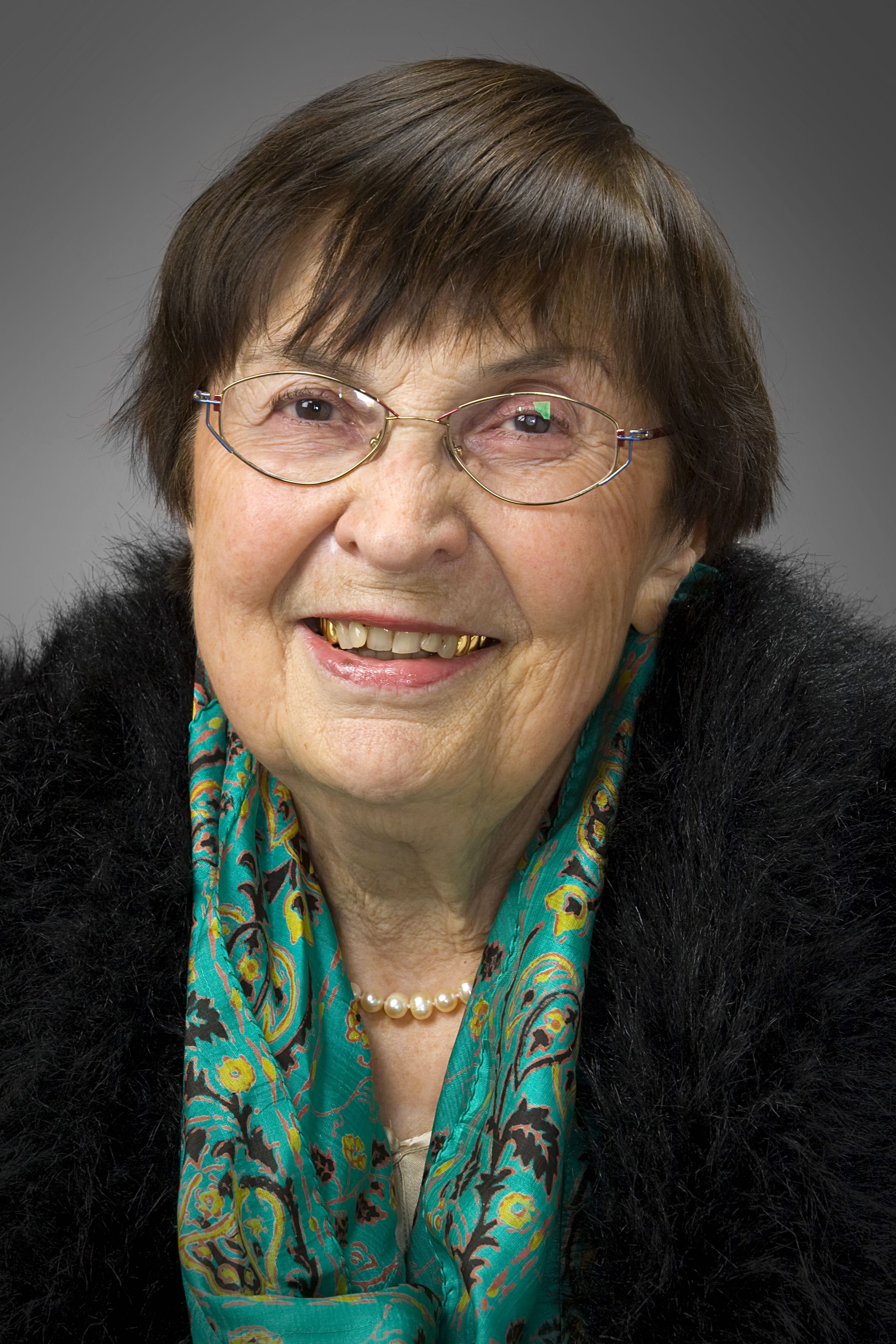
Prof. Dr. Nina Gerasymova-Persydska (1927–December 2020), formerly the chair of the early music department at the Ukrainian National Tchaikovsky Academy of Music, was a prominent Ukrainian musicologist, public figure, and teacher. One of her primary institutional and intellectual missions and accomplishments was to open Ukrainian music and musicology to the global scholarly community.
From the 1960s onward, her research focused on Ukrainian church polyphony of the late seventeenth and eighteenth centuries (the so-called partessny concerti and motets). Her study of nearly 700 compositions from Kyiv’s archives generated an alphabetical index and catalog, as well as several editions of works held in the city’s archives from Ukraine, Russia, and Serbia. Gerasymova-Persydska rediscovered musical compositions by Mykola Dyletsky, long known only as a music theorist. Gerasymova-Persydska’s extensive publications revolutionized our understanding of the development of Ukrainian polyphony music in the Baroque, partessny concerti—concertos for many parts—became understood as interconnected with western European musical culture. At the same time, Gerasymova-Persydska wrote many articles about contemporary music. She explored the creativity of Valentyn Sylvestrov, Witold Lutosławski, György Ligeti, Svyatoslav Lunyov, Maxim Shalygin, and others. Here, she focused on the philosophical problems of musical time and music cognition.
A pillar of Gerasymova-Persydska’s activity was educational and organizational work. She represented Ukrainian musicology at numerous international conferences, took part in the work of international organizations (including the International Musicological Society, the International Council on Traditional Music, UNESCO). She spearheaded organization of many musicological conferences in Kyiv that were dedicated to the different aspects of early and contemporary art music.
Iryna Tukova is chair of music theory at the P.I. Tchaikovsky National Music Academy of Ukraine.
Jamala
In 2016, Jamala, a pop star with Crimean Tatar roots, represented Ukraine at the Eurovision Song Contest, and won. She performed the lyrical song “1944,” named after the year of the brutal Stalinist deportation of Crimean Tatars from Crimea. This historical trauma, the Sürgün, is commemorated annually on May 18 by the Crimean Tatars, who are the predominantly Sunni Muslim Indigenous group of Crimea.
Jamala’s “1944” nests within it references to two well-known Crimean Tatar songs. The chorus, sung in the Crimean Tatar language, repurposes the lyrics from “Ey, Güzel Qirim” (Oh, My Beautiful Crimea). This song was an anthem of the historic human rights campaign Crimean Tatars began in the late 1960s, agitating for the right to return to Crimea. (The campaign succeeded, after nearly twenty years, and Crimean Tatars were finally allowed the right to return in the late 1980s, just before the dissolution of the Soviet Union, after which Crimea became an Autonomous Republic within independent Ukraine.) The climax of the song—a virtuosic melismatic wail—recalls the sinuous melody of “Arafat Daği,” a much older Crimean Tatar song. This intertextuality harkens back to sedimented histories of trauma, dislocation, longing for home. But it is not only backwards-facing.
At her moment of triumph at Eurovision in 2016, Jamala was also singing about the forced occupation of Crimea in 2014 by Putin’s Russia, and about the ongoing human rights abuses against Crimean Tatars there. She was singing about the reason that she, like so many other Crimean Tatars, had become “internally displaced persons” within mainland Ukraine after 2014. “1944” was, in other words, a song that simultaneously commemorated a long historical sweep of this often-overlooked Indigenous group of Ukraine, but also made a wish for the restoration of Crimean sovereignty to Ukraine. Its presence in the competition caused a scandal, and the victory of Ukraine that year was perceived as a condemnation of Russian aggression towards Ukraine.
Now, a refugee who crossed the Ukrainian border with her children after the war broke out, leaving her husband behind to defend their home, Jamala has become a musical ambassador, bringing “1944” to audiences across western Europe and raising funds for the Ukrainian defense. No longer just a plea for the dignity and sovereignty of Crimean Tatars within the space of Ukraine, “1944” has become a heartbreaking plea for the sovereignty of the whole of Ukraine.
Maria Sonevytsky teaches at Bard College and is the author of Wild Music: Sound and Sovereignty in Ukraine.
Taras Kompanichenko
Taras Kompanichenko is a singer-instrumentalist who has been honored on a national level for his skill in performance with Ukraine’s national instrument, the bandura. The bandura is derived from a lute known as the kobza, which was popular among the Ukrainian Cossack warriors beginning in the sixteenth century and later was played by blind musicians (kobzari) who held prominent positions in villages as purveyors of history, news, and religious songs, while donating a portion of their earnings to the upkeep of the local Orthodox Christian churches. In the 1930s, since solo performers were antithetical to Stalinist collectivization, the kobzari were targeted for annihilation. The Soviets developed the bandura for mass manufacturing and distribution to public schools with the intent to collectivize musical ensembles. However, the Soviet ban of the kobza only served to galvanize the Ukrainian people’s resolve to maintain their traditional music; the kobza is, therefore, still played in performance—as is the bandura. Read further portraits of bandurists and their ensembles here.
Taras performs in both solo and ensemble settings and has made several recordings, including of Cossack songs and ballads. Although he is not blind, Taras remains true to the history of the instrument, performs internationally, and is respected as a modern-day kobzar. A volunteer in the territorial defense force in the ongoing war, Taras recently performed in uniform at a wedding on the front.
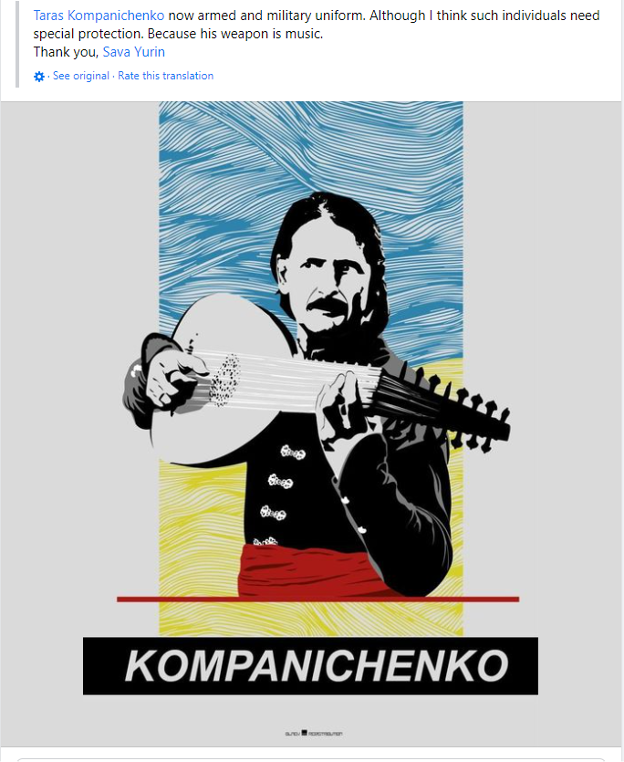
An image posted on social media drawing attention to Kompanichenko’s participation in the ongoing war.
Laurie Semmes researches Ukrainian-American bandura education and teaches ethnomusicology at Appalachian State University.
Kyiv Symphony Orchestra
The Kyiv Symphony Orchestra is a state orchestra with forty years of history, currently experiencing a decisive musical reorientation. I—Luigi Gaggero, an Italian—have been principal conductor since 2018 and work to foster a rare blend of the sensual musicality typical of Ukrainian ensembles with an analytic attitude towards the musical text emphasized in western European training. The choice to engage a foreign principal conductor, unusual among Kievan orchestras, was the product of the musicians’ ambition: they sought to bring to life musical interpretations that are at once fresh, historically informed, and moving.
The orchestra’s distinctive ensemble sound comes from rehearsing “ad libitum.” That is, we prepare every program over several weeks, taking the greatest care with respect to each detail of the score. Each concert program is conceived as an exciting journey through works of different eras and styles that are connected by the threads of shared themes or influences. The international repertoire of the orchestra stretches from music of the sixteenth century through the youngest of today’s composers, such as works by Igor Zavgorodnii, while taking care to preserve and promote Ukrainian musical treasures in recordings of Borys Liatoshynsky’s symphonies and the Hutsul-inspired triptych by Myroslav Skoryk. With thorough preparation, the orchestra gives more than ninety concerts every year in concert halls, at festival venues, and in the open air. All these activities together have resulted in the consistent growth of the orchestra’s audience. In recent years, the concerts of the Kyiv Symphony Orchestra have been among the main events in the cultural life of Ukraine.
Luigi Gaggero is the principal conductor of the Kyiv Symphony Orchestra.
Julian Kytasty
Julian Kytasty, a native of Detroit, is one of the world’s leading bandura players–for a brief history of his instrument, also called the Ukrainian lute-harp, read here. Born into a family of musicians who came to the United States as Displaced Persons after the Second World War, Kytasty inherited a rich musical tradition and developed it to become one of the most important bandurists of his generation. A multi-instrumentalist, singer, and composer, he has concertized and taught students around the world and created award-winning music for film and theater. In the period leading up to the dissolution of the Soviet Union (1989–90), Kytasty was one of the first North American-born bandurists to tour Ukraine. Returning since the country’s independence, he has developed close contacts with Ukrainian musicians, including Taras Kompanichenko. In September of 2021, President Volodymyr Zelensky awarded him with the distinction of Honored Artist of Ukraine (Заслужений Артист України/Zasluzhenyi Artyst Ukrainy).
Kytasty is especially recognized for his expertise in the early bandura repertoire, including Ukraine’s epic songs. These carry oral histories—moralistic tales of life in historical Ukraine—and are key to the sustainability of this uniquely Ukrainian instrument. A repository of performance video and discussion of the continuing relevance of these epic songs has been curated here.
Kytasty has opened new possibilities for his instrument. His collaborations include projects with musicians from many other cultures and musical traditions, such as the pipa player Wu Man, griot Papa Suso, musician and scholarl Michael Alpert, composer John Zorn, and improvisational guitarist Derek Bailey. A favorite ensemble project was the Experimental Bandura Trio, in which his student Jurij Fedynskyj played before emigrating to Ukraine.
Kytasty’s album Songs of Truth, co-produced in 2014 with Marcia Ostashewski, will be re-released on the Smithsonian Folkways Recordings label in spring 2022. The title track, the historical “Song of Truth” arose from a time of turmoil and social upheaval in Ukraine, in ways that resonate with the current war. A video recording of Kytasty singing the song in 1989 is cued up in the below lecture; learn more about it and access the lyrics here.
Marcia Ostashewski researches music and dance among Indigenous and immigrant communities in Canada and is the director of the Centre for Sound Communities at Cape Breton University.
Andrii Mokrytskyi
In September 2018, I had the extraordinary good fortune of traveling to Kyiv to record a CD of my music called Iridescent Notation (2020) with the Ukho Ensemble Kyiv under the direction of Luigi Gaggero. In my career, I have only very rarely had such perfect working conditions. Everyone collaborated with extraordinary focus to make this happen, often going far beyond what is normally asked of performers in such a situation. Recording a CD, especially of difficult new compositions requiring a wide array of instrumental combinations, is a complicated business, and the success of such projects is dependent on the engagement of everyone involved; but perhaps no one is so crucial as the principal recording engineer. In this I was fortunate to be working with Andrii Mokrytskyi.
Andrii has that rare profile that makes him ideally suited to projects like this: an immensely cultivated person, excellent musician, and able to read complex scores and make rapid artistic judgements. He is a superb technician who possesses the quiet patience and focus necessary to keep things moving along without undue stress in what is generally an intense situation. You can hear more about the details of our recording process and the artistic collaboration here. Working with Andrii gave me complete confidence that the project would be a success, which it was — showing the world what Ukrainian musicians and technicians can do at the very highest levels of artistic accomplishment. Writing this in mid-March 2022, my thoughts are never far from brilliant creatives like Andrii, and I join the entire world in wishing for a swift end to the calamitous and criminal Russian aggression in Ukraine.
Samuel Andreyev is a Canadian composer based in France.
Lyuba Morozova
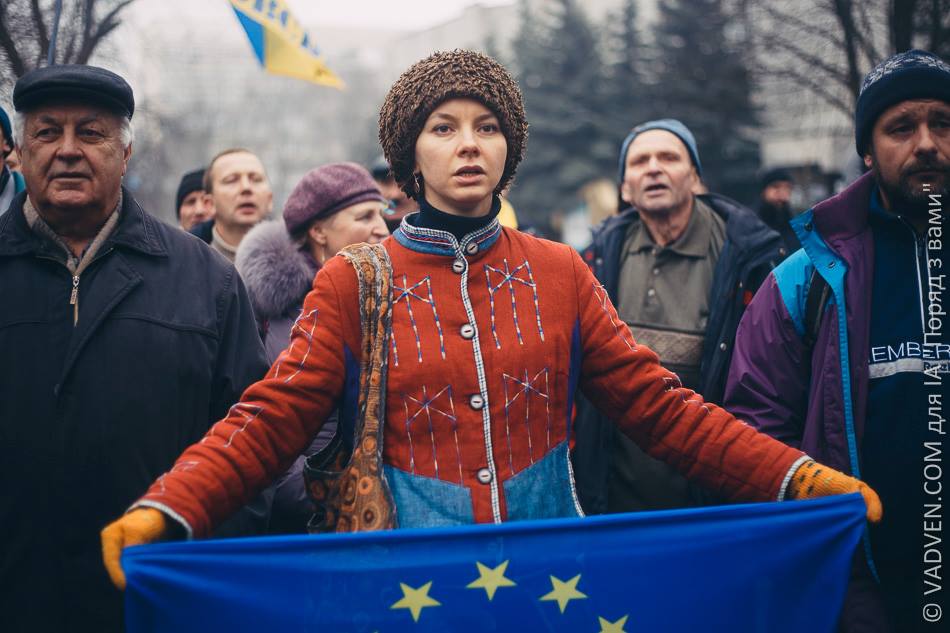
Lyuba Morozova at the Maidan holding the flag of the European Union. Photograph by Vadim Vadven, used with permission.
I am a musicologist, television and radio host, music program curator for several Ukrainian festivals, and the artistic director of the Kyiv Symphony Orchestra. Since 2005 I have worked as a music critic for Ukrainian publications, but I have also played the role of curator, beginning with a project at an art forum in Kyiv in 2014. This project, called DONKULT, was dedicated to the art of Donbass and a response to the 2014 onset of Russian aggression in eastern Ukraine. The aim of the curators—from across the arts—was to remind Kyivans that Donbass is and was a part of Ukraine, and that its unique culture is inextricably linked with the history and customs of other regions of Ukraine. Here is one highlight from my work as festival curator, see also a presentation that includes video footage that I made as part of the 2021 Ukrainian Contemporary Music Festival in the United States here.
We are faced with a paradox: in order to gain recognition in their homeland, a Ukrainian musician must first be recognized in the West. Since 2018, the outdoor festival Bouquet Kyiv Stage has been devoted to showcasing Ukrainian musicians with international careers. One of the important features of the festival is that all events take place at significant historical sites, such as at the Golden Gates. On Ukrainian Independence Day in 2019 the concerts unfolded as night fell at St. Sophia Cathedral. A performance by the Telnyuk Sisters accompanied by the Presidential Orchestra of Ukraine presented settings of major Ukrainian poets Bohdan-Ihor Antonych and Taras Shevchenko, as well as Pope John Paul II and Paul Celan. Read more about that year’s festival here. The Swiss new music group Ensemble Proton Bern performed Antoine Chessex’s Les Abîmes Hallucinés (Abyss of Hallucinations), a work composed as a 50-minute rustle theater. Near midnight, pianist Yevhen Hromov played a program dedicated to birds and the night.
Alina Pash
Born in the western Ukrainian village of Bushtyno in Zakarpattia Oblast, singer Alina Pash moved to Kyiv to study at the Municipal Academy of Circus and Variety Arts. The transition from village to city is a recurring theme in Pash’s work, as she bridges the gap between urban and rural dimensions of her musical and personal identity. Pash’s performance style alternates between the bright, open sound of Ukrainian “white voice” singing, techno beats, and rapping in Ukrainian and English. Ukrainian traditional instruments make frequent appearances in her work, including sopilka (ca. 1:00 in this video), tsymbaly, drumba, and bandura. Her music displays an eclectic range of additional influences, including those from Latin and Arab popular music genres.
Pash’s tendency to oscillate between the rural and urban is best illustrated in her premiere album, PINTEA, named for the Ukrainian historical figure turned legend, Grigore Pintea. The album is in two parts. The first, Gory (Mountains), features songs about village life using Ukrainian traditional music elements. For example, the track below, “Bosorkanya” (Sorceress), references practices associated with St. Andrew’s Day, a syncretic pagan-Orthodox holiday in which women engage in divination practices to determine their future husband. Part two, Misto (City), utilizes an electronic, multiethnic sound. Its tracks sample the Indian sitar (“Dela”) and Chinese opera gong (“Ocean”), and include collaborations with artists rapping or singing in English, French, Russian, and Georgian. Thus, Pash’s work remains rooted in her Ukrainian heritage, while simultaneously situating Ukrainian music within the global hip-hop arena.
Melissa Bialecki Miller studies ethnomusicology at the University of Illinois Urbana-Champaign, where her dissertation research explores hip-hop’s role in shaping and facilitating emergent feminisms in post-Maidan Ukraine.
Valentyn Sylvestrov

The cover art for Sylvestrov’s Instantaneous Waltzes – I (Мгновенные вальсы – I, 2021)
One of the most visible of contemporary Ukrainian composers, and a revered grandfather of Ukrainian new music, the 84-year-old Valentyn Sylvestrov (b. 1937) has engaged multiple stylistic tactics over the past sixty years. Since the early 1970s, he has excelled at creating never-ending sonic meditations whose melodies emerge from the past yet linger into the future. But after the independence of Ukraine in 1991 and especially after the Euromaidan revolution from late 2013 through early 2014, Sylvestrov’s meditations became prayers for the future of Ukraine, expressing both consolation and grim determination.
Hyper-engaged, like all Ukrainians at the time, with the Maidan protests, Sylvestrov composed a series of short songs that he later expanded into the choral cycle Maidan-2014. At the core of this work sit five new settings of the Ukrainian national anthem. A searing assessment of a critical turning point in Ukrainian history, Maidan-2014 has gained new, unwanted currency since the devastating Russian invasion of Ukraine on February 24, 2022. Several of its movements have been posted on the YouTube channel curated by Sylvestrov’s friend and supporter, Konstantin Sigov, an esteemed Ukrainian academic and publisher (of the Duh i litera publishing house). Here is one, a “sketch” sung by Sylvestrov himself, composed at the climax of the Maidan protests on February 18-19, 2014; it is movement seven of Maidan-2014. And here is the full cycle in two versions, the first by Sylvestrov, the second by Mykola Hobdych’s Kyiv Chamber Choir.
Peter J. Schmelz teaches musicology at Arizona State University and recently published Sonic Overload, a study of polystylism and the music of Alfred Schnittke and Valentyn Sylvestrov.
Alla Zahaykevych
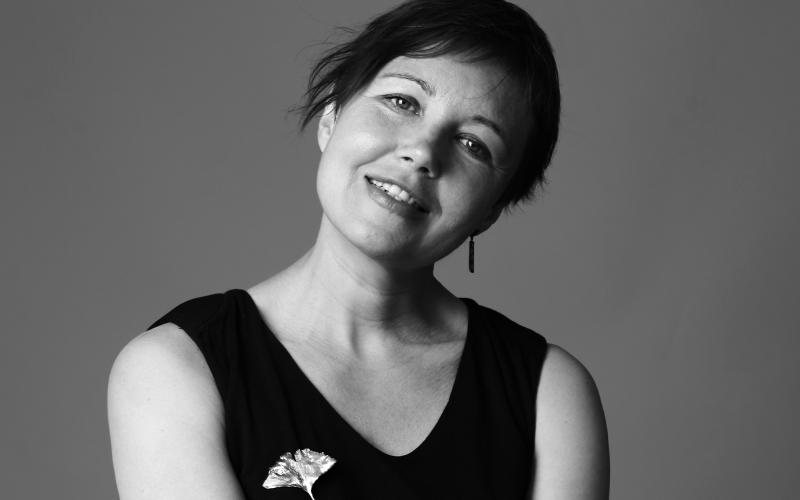
The music of Alla Zahaykevych (b. 1966) has helped to define Ukraine’s robust electroacoustic music scene for decades. After studying composition and orchestration with Yuriy Ishchenko at the National Music Academy of Ukraine in Kyiv, Zahaykevych attended the annual course in composition and musical informatics at IRCAM, an institution for the research and production of avant-garde and computer music, in Paris in 1995-96. She founded the Electroacoustics Music Studio in at the National Music Academy of Ukraine in 1997 and has served as president of the Electroacoustic Music Association of Ukraine since 2010.
Zahaykevych spent several years as part of the folk ensemble Drevo, directed by ethnomusicologist Yevhen Yefremov. During that time she studied music through ethnography, talking and performing with others. This experience has informed her compositions in the years since. Her works often links electronic composition to folk traditions, such as her collaboration with singer Iryna Klymenko and violinist Serhiy Okhrimchuk in Nord/Ouest and with bandurist Julian Kytasty in Disturbance Fields. (Learn more about Kytasty in this gallery.)
She has also written music for film, including iconic Ukrainian films Mamay (2003) and Povodyr (The Guide, 2014). Among Zahaykevych’s most recent projects is electro-acoustic opera Vyshvanyy: Korol’ Ukrainy (Vyshyvanyy. King of Ukraine), which premiered in Kharkiv in October 2021. With a libretto by Ukrainian poet Serhiy Zhadan, the opera explores the story of Wilhelm van Habsburg—or Vasyl Vyshyvanyy as he is known in Ukraine—an Austrian prince who fought for Ukrainian independence and died for it, tortured by the KGB in 1948.
In addition to her active composition career, Zahaykevych has written articles that lay the scholarly foundation for the study of electronic music in Ukraine. She curated a program of electro-acoustic compositions from Ukraine across generations for the second annual Ukrainian Contemporary Music Festival in New York in 2021. The pre-concert talk she prepared for this concert is a lesson in Ukrainian music and history: it deserves the attention of anyone interested in understanding this art music scene’s interaction with twentieth and twenty-first century repertories.
As of this writing, she remains in Kyiv. She is composing and working on various cultural fronts when not sheltering from Russian bombs underground.
Leah Batstone is a musicologist researching art music in relation to Ukrainian politics at the University of Vienna. She is the artistic director of New York’s Ukrainian Contemporary Music Festival.
Olesya Zdorovetska
Trained as a jazz singer at the Kyiv Glière Music College, Olesya Zdorovetska is a multidisciplinary artist with strong commitment to social justice, whose creative oeuvre defies genre, linguistic and geographical boundaries. Singing in English, Spanish, Ladino, and Ukrainian, she has performed traditional and experimental jazz, Afro-Caribbean music, and contemporary renditions of folklore. She has also created imaginative installations of sound art.
Since Dislocados, the first salsa band in Ukraine, was founded in 2005, Zdorovetska has been one of its lead singers. The group has positioned itself as a collective independent musicians from an independent nation and released their previously planned single “La Campana” on March 4, 2022, to show that “even the war cannot stop [them].”
In 2011, together with Dublin-based composer and producer Nick Roth, Zdorovetska created Water project—a series of compositions and multimedia performances exploring the nature of water through sound. Having performed it across Europe, they brought it to Gogol Fest in Kyiv in 2012.
Following the Revolution of Dignity, Zdorovetska composed and performed a solo project Telling Sounds, a multimedia performance and an album of songs, setting contemporary Ukrainian poetry for voice and citera. The texts in this cycle address freedom, war and commemorate the heroes of the 2014 revolution.
Involved with multiple projects in Dublin, Zdorovetska regularly returns to Ukraine to perform with bassist Mark Tokar, vocalist Nazgul Shukaeva, and multi-instrumentalist Oleksandr Fraze-Frazenko, among others. The escalation of war has caught her in Kyiv, and she decided to stay there to volunteer, coordinating internally displaced persons and refugees.
Oksana Nesterenko is a musicologist preparing a book with the working title “A Forbidden Fruit? Religion, Spirituality, and Music in the USSR before Its Fall.”
If you are a scholar of music from Ukraine and would like to add a portrait, please contact the editors by email to introduce yourself.


